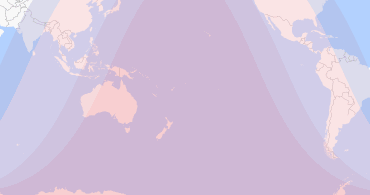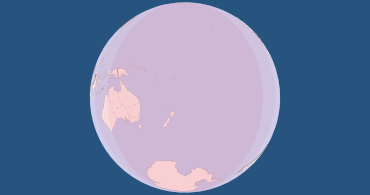A partial lunar eclipse is visible in areas such as the Pacific and eastern Australia on June 26, 2010. This is the first lunar eclipse in 2010 and the second of all eclipses that occur throughout the year.
This eclipse was visible in Columbus - go to local timings and animation
Where the Eclipse Was Seen
Try our new interactive eclipse maps. Zoom in and search for accurate eclipse times and visualizations for any location.
Regions seeing, at least, some parts of the eclipse: Much of Asia, Australia, Much of North America, South America, Pacific, Atlantic, Indian Ocean, Antarctica.
This eclipse was visible in Columbus - go to local timings and animation
Eclipse Map and Animation
Eclipse was visible.
Only partial phase was visible. Missed partial phase.
Eclipse was not visible at all.
Note: Areas with lighter shadings left (West) of the center will experience the eclipse after moonrise/sunset. Areas with lighter shadings right (East) of the center will experience the eclipse until moonset/sunrise. Actual eclipse visibility depends on weather conditions and line of sight to the Moon.
When the Eclipse Happened Worldwide — Timeline
Lunar eclipses can be visible from everywhere on the night side of the Earth, if the sky is clear. From some places the entire eclipse will be visible, while in other areas the Moon will rise or set during the eclipse.
| Eclipse Stages Worldwide | UTC Time | Local Time in Columbus* | Visible in Columbus |
|---|---|---|---|
| Penumbral Eclipse began | Jun 26 at 08:57:23 | Jun 26 at 4:57:23 am | Yes |
| Partial Eclipse began | Jun 26 at 10:17:00 | Jun 26 at 6:17:00 am | No, below the horizon |
| Maximum Eclipse | Jun 26 at 11:38:28 | Jun 26 at 7:38:28 am | No, below the horizon |
| Partial Eclipse ended | Jun 26 at 12:59:48 | Jun 26 at 8:59:48 am | No, below the horizon |
| Penumbral Eclipse ended | Jun 26 at 14:19:34 | Jun 26 at 10:19:34 am | No, below the horizon |
* The Moon was below the horizon in Columbus some of the time, so that part of the eclipse was not visible.
Quick Facts About This Eclipse
| Data | Value | Comments |
|---|---|---|
| Magnitude | 0.536 | Fraction of the Moon’s diameter covered by Earth’s umbra |
| Obscuration | 50.6% | Percentage of the Moon's area covered by Earth's umbra |
| Penumbral magnitude | 1.578 | Fraction of the Moon's diameter covered by Earth's penumbra |
| Overall duration | 5 hours, 22 minutes | Period between the beginning and end of all eclipse phases |
| Duration of partial phase | 2 hours, 43 minutes | Period between the beginning and end of the partial phase |
| Duration of penumbral phases | 2 hours, 39 minutes | Combined period of both penumbral phases |
Eclipse calculations usually accurate to a few seconds
How Many People Can See This Eclipse?
| Number of People Seeing... | Number of People* | Fraction of World Population |
|---|---|---|
| At least some of the penumbral phase | 4,130,000,000 | 59.15% |
| At least some of the partial phase | 2,730,000,000 | 39.16% |
| All of partial phase | 229,000,000 | 3.29% |
| The entire eclipse from beginning to end | 34,800,000 | 0.50% |
* The number of people refers to the resident population (as a round number) in areas where the eclipse is visible. timeanddate has calculated these numbers using raw population data provided by the Center for International Earth Science Information Network (CIESIN) at Columbia University. The raw data is based on population estimates from the year 2000 to 2020.

An Eclipse Never Comes Alone!
A solar eclipse always occurs about two weeks before or after a lunar eclipse.
Usually, there are two eclipses in a row, but other times, there are three during the same eclipse season.
This is the first eclipse this season.
Second eclipse this season: July 11, 2010 — Total Solar Eclipse

